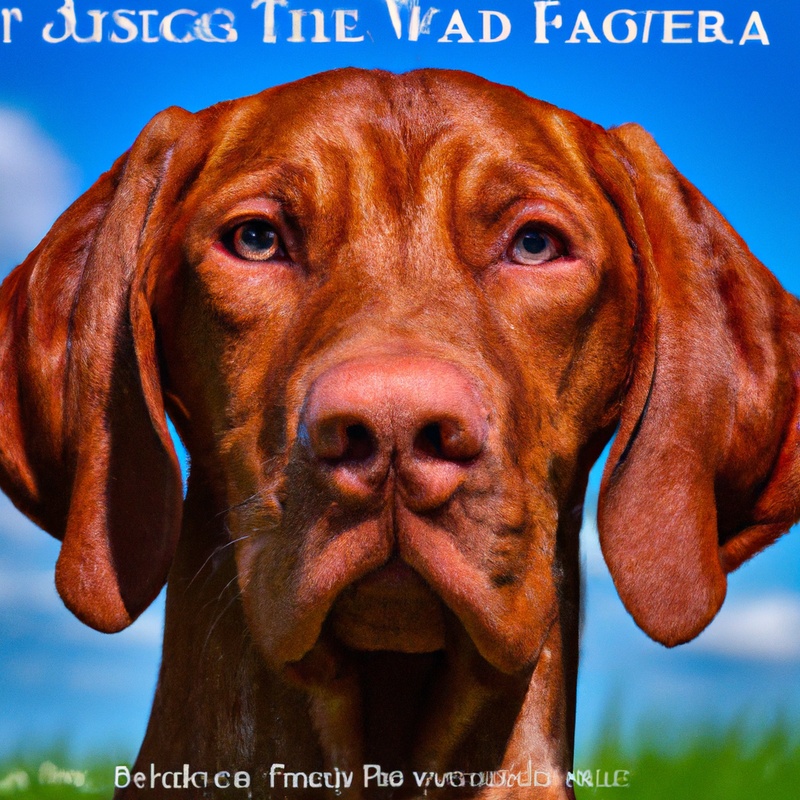How Do I Handle Vizsla’s Barking At People Passing By The House On Walks?
Key Takeaways:
- Establish clear boundaries and consistent training to address Vizsla’s barking at people passing by the house on walks.
- Use positive reinforcement techniques and reward calm behavior to discourage excessive barking.
- Engage Vizsla in regular exercise to minimize anxiety and excessive barking.
- Seek professional help if the barking behavior persists despite your efforts.
Does your Vizsla go into a barking frenzy every time someone walks by your house? You’re not alone.
Dealing with a Vizsla’s barking at people passing by can be quite a challenge.
Hi there, I’m here to help you understand why Vizslas exhibit this behavior and provide you with some practical tips on how to address it. As an expert in dog behavior and training, I’ve worked with numerous Vizsla owners who have faced the same issue.
So, let’s dive in and find out how you can handle your Vizsla’s barking and restore peace on your walks.
| Issue | Solution |
|---|---|
| 1. Understand the cause | Identify why your Vizsla is barking at people passing by. It could be fear, territorial behavior, or lack of socialization. |
| 2. Desensitize and counter-condition your dog | Gradually expose your Vizsla to the trigger (people passing by) at a distance and reward them for calm behavior. Increase the proximity over time. |
| 3. Train a “quiet” or “settle” command | Teach your Vizsla a cue to stop barking or to settle down in a designated spot when people pass by. |
| 4. Manage the environment | Block your dog’s access to windows or use curtains to limit visual stimulation. Close doors or use baby gates to prevent access to areas where barking frequently occurs. |
| 5. Socialize your Vizsla | Expose your dog to various people and situations to build confidence and reduce fear or anxiety. |
| 6. Seek professional help | If the problem persists or escalates, consult with a professional dog trainer or behaviorist for guidance and personalized solutions. |
Understanding the Vizsla breed
Vizsla breed characteristics
Vizslas are known for their energetic and lively nature. They are a medium-sized breed with a sleek, golden rust coat that demands minimal grooming.
Vizslas are incredibly affectionate and thrive on human companionship, making them great family pets.
They are also excellent hunting dogs, possessing natural instincts and a keen sense of smell. This breed requires regular exercise to keep them mentally and physically stimulated.
Giving them plenty of opportunities to run and play will help prevent boredom and potential behavioral issues.
With proper training, socialization, and lots of love, Vizslas can make wonderful, loyal companions.
Vizslas and their energy levels
Vizslas are high-energy dogs by nature. They have an abundance of energy that needs to be properly channeled in order to keep them happy and healthy.
Regular exercise is key for Vizslas to release their energy and prevent unwanted behaviors.
They thrive in active households and enjoy activities like running, hiking, and playing fetch. Mental stimulation is also important for these intelligent dogs, so providing puzzle toys and training sessions can help tire them out.
It’s important to give them plenty of exercise and mental stimulation to keep them content and prevent excessive barking or other behavioral issues.
Reasons behind Vizsla’s barking at people passing by
Protective instinct of Vizslas
Vizslas have a strong protective instinct.
They are bred for hunting and guarding, so it’s natural for them to be alert and wary of strangers.
This instinct can sometimes manifest as barking at people passing by the house or during walks.
To handle this behavior, provide proper socialization from a young age, use positive reinforcement training, and redirect their attention.
Avoid punishment, as it can worsen the behavior.
Consulting a professional dog trainer can also be beneficial.
Lack of socialization and fear
Lack of socialization and fear are common reasons for a Vizsla’s barking at people passing by. When a Vizsla hasn’t been exposed to different people and situations, they may feel anxious and react by barking.
This could be due to fear of the unknown or a lack of trust in unfamiliar individuals.
It’s essential to focus on proper socialization from a young age to build their confidence and reduce fear-based behaviors. Gradual exposure to various environments, people, and positive reinforcement can help address these issues.

Separation anxiety and boredom
Separation anxiety and boredom are common reasons behind a Vizsla’s barking at people passing by. When left alone for long periods, Vizslas can become anxious and bark as a way to cope with their distress.
Additionally, these energetic dogs need plenty of mental and physical stimulation, so boredom can lead to excessive barking.
Providing mental enrichment, regular exercise, and gradually desensitizing your Vizsla to being alone can help address these issues. Seek professional help if the barking persists.

Tips for handling Vizsla’s barking at people passing by
Proper socialization and training
Proper socialization and training are essential for your Vizsla.
Here’s how to do it right:
- Begin socialization early: Expose your Vizsla to different people, animals, and environments from a young age.
- Use positive reinforcement: Reward good behavior with treats, praise, and play. This will help your Vizsla associate positive experiences with social interactions.
- Gradual exposure: Start with calm and controlled environments, gradually increasing the level of distractions as your Vizsla becomes more comfortable.
- Consistency is key: Establish a consistent training routine and stick to it. This will help your Vizsla understand the desired behaviors.
- Seek professional help if needed: If you’re struggling with training or socialization, consider consulting a professional dog trainer for guidance. They can provide valuable insights and techniques.
Remember, patience and consistency are crucial throughout the socialization and training process.
With time and effort, your Vizsla will become well-behaved and comfortable in various situations.

Positive reinforcement techniques
Positive reinforcement techniques are an effective way to handle a Vizsla’s barking at people passing by. One technique is to reward your dog with treats and praise when they remain calm and quiet.
Another technique is to redirect their attention with a toy or a game.
Consistency is key, so be sure to reward them every time they exhibit the desired behavior. This will help them associate being calm with positive outcomes and encourage them to bark less in the future.
Creating a positive association with strangers
Creating a positive association with strangers is key for a Vizsla’s behavior.
Here’s how to do it:
- Start early: Expose your Vizsla to different people from a young age.
- Use treats and rewards: Give your Vizsla treats when they interact calmly with strangers.
- Positive reinforcement: Praise and reward your Vizsla when they approach strangers in a friendly manner.
- Gradual exposure: Gradually increase the level of interaction with strangers over time.
- Consistency is key: Practice these steps consistently to reinforce positive associations.
Regular exercise and mental stimulation
Regular exercise and mental stimulation are vital for the overall well-being of your Vizsla. This breed is known for their high energy levels and intelligence, so it’s important to provide them with plenty of physical activity and mental challenges.
Take your Vizsla for daily walks or runs to help burn off their energy, and consider engaging in activities such as obedience training, agility courses, or puzzle toys to keep their minds sharp.
This will not only prevent boredom and destructive behavior but also strengthen the bond between you and your furry friend.
Managing Vizsla’s barking on walks
Using no-pull harness or gentle leader
When it comes to managing a Vizsla’s barking on walks, using a no-pull harness or gentle leader can be helpful.
These devices provide more control and minimize pulling, which can help redirect your dog’s attention away from distractions.
The no-pull harness attaches to the front of the dog’s chest, while the gentle leader fits over their muzzle and redirects their head when they try to pull.
Both options can be effective, but it’s important to choose one that your dog is comfortable with and properly introduce it to them.
Remember to always use positive reinforcement and reward good behavior.
Diverting attention with toys or treats
One way to handle your Vizsla’s barking at people passing by the house on walks is to divert their attention with toys or treats. When you notice your dog getting triggered, quickly redirect their focus by offering them a toy or a treat.
This can help distract them from the stimulus and redirect their energy into something positive.
Make sure to carry a few toys or treats with you during walks so that you are prepared whenever the need arises.
Utilizing desensitization and counterconditioning techniques
Utilizing desensitization and counterconditioning techniques is a helpful approach when dealing with behavioral issues in dogs.
Desensitization involves gradually exposing your Vizsla to the trigger, such as people passing by on walks, at a distance that doesn’t provoke barking.
Over time, you can decrease the distance and reward your dog for remaining calm.
Counterconditioning involves pairing the trigger with positive experiences, like treats or playtime, to create a positive association.
This helps your Vizsla learn to associate the trigger with something pleasant, reducing their urge to bark.
Seeking professional help if necessary
Sometimes, despite our best efforts, we may find that we’re unable to manage our Vizsla’s barking on walks. In these cases, seeking professional help from a dog trainer or behaviorist can be a good option.
They have the expertise and experience to assess your Vizsla’s behavior and provide personalized training techniques and strategies.
Professional guidance can give you the tools and knowledge needed to address your Vizsla’s barking effectively and ensure a more enjoyable walking experience for both you and your furry friend.
Frequently Asked Questions
Can Vizslas be trained to stop barking at people passing by?
Absolutely! Vizslas can definitely be trained to stop barking at people passing by. It will require consistency, patience, and positive reinforcement.
Here are a few tips to help you with the training process:
- Start by identifying the triggers that cause your Vizsla to bark. Is it the sight of people, the sound of footsteps, or something else? Understanding the root cause will help you address it effectively.
- Gradually desensitize your Vizsla to the triggers by exposing them to the stimuli in controlled situations. Start at a distance where your dog remains calm and reward them with treats and praise for their calm behavior.
- Use positive reinforcement techniques to redirect your dog’s attention away from the triggers. Teach them alternative behaviors, such as sitting or lying down, and reward them when they exhibit these behaviors instead of barking.
- Consider enrolling your Vizsla in obedience classes or working with a professional dog trainer who specializes in behavior modification. They can provide you with valuable guidance and support throughout the training process.
Remember, training takes time and consistency. With patience and positive reinforcement, you can help your Vizsla overcome their barking behavior and enjoy peaceful walks together.
How long does it take to see improvements in a Vizsla’s behavior?
Improvements in a Vizsla’s behavior can vary depending on the individual dog and the specific behavior being addressed.
Some dogs may show progress within a few weeks, while others may take several months.
Consistency, patience, and positive reinforcement are key.
It’s important to establish clear expectations and boundaries, provide proper training and socialization, and address any underlying issues.
Seeking guidance from a professional dog trainer or behaviorist can also help expedite the process.
Remember, every dog is unique, so the timeline may differ.
What if my Vizsla’s barking escalates or becomes aggressive?
If your Vizsla’s barking escalates or becomes aggressive, it’s important to address the issue promptly. Here are a few steps you can take:
- Identify the triggers: Pay attention to what specifically sets off your Vizsla’s barking. Is it certain people, other animals, or specific situations?
- Consult a professional: Reach out to a certified dog trainer or behaviorist who can provide guidance tailored to your Vizsla’s needs. They can help you understand the underlying causes and develop a training plan.
- Positive reinforcement: Use positive reinforcement techniques, such as rewarding calm behavior and redirecting their attention away from triggers. This encourages your Vizsla to associate positive experiences with situations that previously caused barking.
- Desensitize and counter-condition: Gradually expose your Vizsla to the triggers in controlled settings, rewarding them for remaining calm. This process helps them build positive associations and reduces their reactivity over time.
Remember, addressing aggression or escalated barking requires patience, consistency, and professional guidance. It’s important to keep your Vizsla and others safe by addressing the issue promptly and effectively.
Can Vizslas be trained to differentiate between wanted and unwanted guests?
Yes, Vizslas can be trained to differentiate between wanted and unwanted guests.
With consistent and positive training methods, you can teach your Vizsla to recognize the difference between people you welcome into your home and those who are not invited.
The key is to expose your dog to various social situations and provide rewards or praise when they respond appropriately.
Training techniques such as desensitization and counter-conditioning can also be effective in helping your Vizsla understand what behavior is expected when guests arrive.
Remember, patience and consistency are key when training your Vizsla.
Final Verdict
Understanding the reasons behind a Vizsla’s barking at people passing by is crucial in effectively managing their behavior. The protective instinct, lack of socialization, and separation anxiety can all contribute to this behavior.
To handle this issue, proper socialization and training are key, along with positive reinforcement and creating a positive association with strangers.
Regular exercise and mental stimulation can also help manage their energy levels. Additionally, using tools like a no-pull harness or gentle leader, diverting attention with toys or treats, and employing desensitization and counterconditioning techniques can be beneficial.
Seeking professional help is recommended if necessary.
Ultimately, with patience, consistency, and understanding, you can train your Vizsla to behave appropriately when people pass by on walks.








